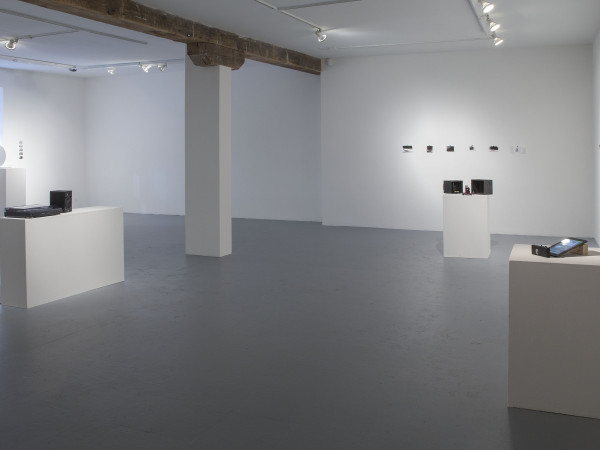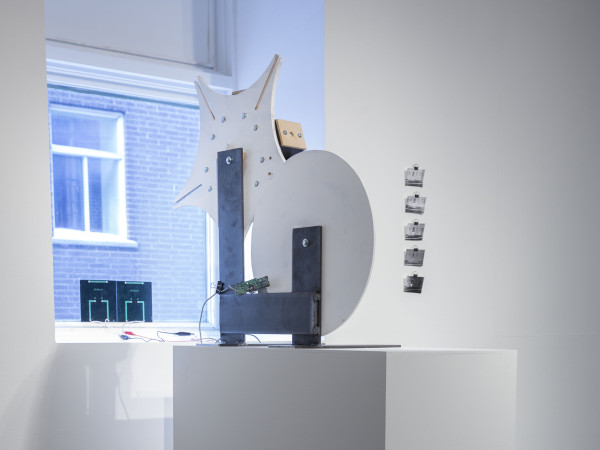Bruno Caldas Vianna makes traps that capture time. The devices that he creates are produced from technological equipment that is considered out-dated. He acknowledges that the exhibition he presented at LA CHAMBRE BLANCHE could evoke a cabinet of curiosities or even the Wunderkammer, “the room of wonders.” Gathering together equipment that has now become obsolescent, the artist’s process resembles that of someone who collects curious objects. Instead of preserving them in a set time, Vianna gives them new life, attributing new functions that are provided by the immediate environment in which they are found.
Dependent on noise, movement or light, Vianna’s creations transmit bits of reality that come from the specific devices. Their reassembly gives us the impression that we are able to simultaneously perceive the world various ways. Rather than presenting differing scales of it like a magnifying glass or a telescope would do, these are fragments of time that are captured.
Certain of the device consist of new interpretations of the camera obscura or pinhole camera. One of them was set in motion with the movement of a wheel activated by daylight. Installed on a window, overlooking rue Christophe Colomb, it captured brief moments of exterior light. The resulting photographs, isolated from their initial reality, are presented as fragments of the neighbourhood. Their small size and the re-transcription of the surrounding area that they provide recall Brassaï’s ideas, which considered photography to be made up of “a true but miniaturising copy of the exterior world.”1
For Vianna, the idea of working with the wheel was inspired by the first cinema recording and projection device, and also by medieval engineering. The artist considers that it is initially this choice of evoking old systems that relates the presentation of his works to those of a cabinet of curiosities. In referring to old processes, the artist captures present time while making allusion to the universal history of the world. The rudimentary nature of some of his machines is closely akin to the archaism of the outmoded processes that he evokes.
Following the analogy that Vianna establishes between his work and the cabinet of curiosities, one could compare these images to reduced versions of the world, formerly recreated in scholarly collections and exhibited with the intention of explaining something. In the 18th century, under the influence of Diderot’s ideas that recommended establishing an “encyclopaedic dictionary of the human spirit”,2 these collections were often elaborated, with minerals or plants in order to reconstruct the conditions in which the specimens were found in a living state. It also could happen that various species were grouped together to simulate an interaction that never existed in reality. The little known parts of science then were filled in by the collector’s imagination. Strange coincidence, in order to talk about his work, the artist frequently uses expressions associated with acts of predation: he describes his works as “light traps for time” and compares himself to a “hunter” tracking his evanescent “prey.”
However these moments, even once “captured” and exhibited, are not subjected to the deadly representation usually created by a museum’s immortalization. Because these works depend on the environment in which they are found, in experiencing them, it is the direct capture of time that one witnesses rather than its interruption. One of the devices is used to put together images from ambient noise that is captured in the exhibition gallery. Appearing progressively on a digital tablet, these images present the archaeological interventions made in the city of Rio. Various strata from the distant past resurface due to variations in time, thus producing a revelation of the past in the present.
Another of the devices, reinterpreting the camera obscura, is used to capture various moments of a subject on the same photosensitive surface. The surrounding urban landscape then is revealed in many fragmented moments. The ghostly images are presented in the negative because their capturing is imprinted directly on the paper. These are the variations of light that show the plurality of the moments of the day, coexisting in the same image. Their demarcations recall the erosion of the ground, which shows the passing of time in an area. Unlike a photograph that results in capturing a single moment, this plurality of instants of a same subject presents a version of the world in which time would be abolished by its reduction.
Because Bruno Caldas Vianna’s devices present various forms of capturing time, bringing them together in the same space opens up the perception of infinity in miniature.3 If the obsolescence attributed to components of the works give the impression that they are out of date, it seems paradoxical that these objects now artefacts, contribute instead to providing for regeneration. On the other hand, the time period that this material comes from is not so long ago. By their simple material presence, this collection of various pieces seems to indicate the world’s acceleration, outmoded by the speed of its technological and media evolution. Consequently, there is very good reason to consider the ensemble as a kind of cabinet of curiosities, which has been adapted to the knowledge and imagination of a time, requiring more exploring and understanding.
- Brassaï. 2001, Proust in the Power of Photography. Trans. Richard Howard, Chicago: University of Chicago press. p. 33.
- Davenne, Christine et Christine Fleurent. 2011, Cabinets de curiosités: La passion de la collection. Paris: De La Martinière editions. p. 16.
- Ibid., p. 66.




